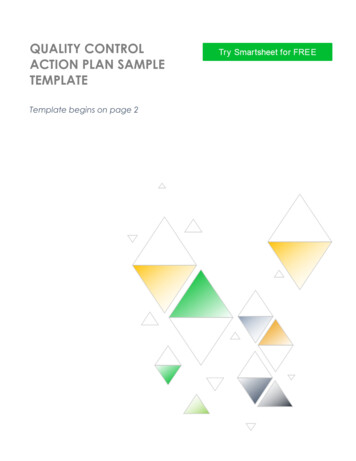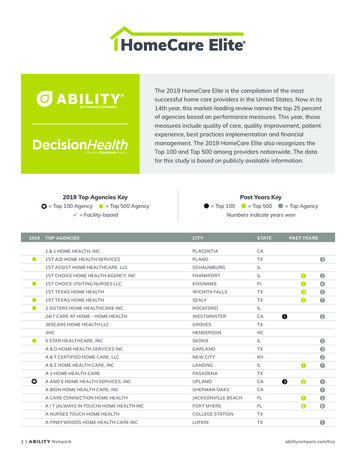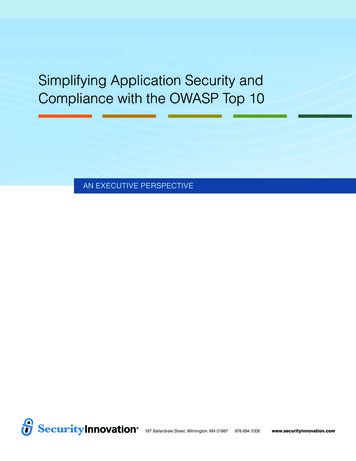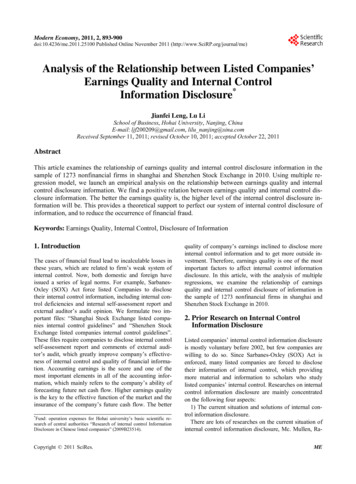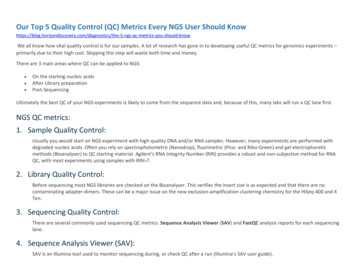
Transcription
Our Top 5 Quality Control (QC) Metrics Every NGS User Should the-5-ngs-qc-metrics-you-should-knowWe all know how vital quality control is for our samples. A lot of research has gone in to developing useful QC metrics for genomics experiments –primarily due to their high cost. Skipping this step will waste both time and money.There are 3 main areas where QC can be applied to NGS: On the starting nucleic acidsAfter Library preparationPost-SequencingUltimately the best QC of your NGS experiments is likely to come from the sequence data and, because of this, many labs will run a QC lane first.NGS QC metrics:1. Sample Quality Control:Usually you would start an NGS experiment with high-quality DNA and/or RNA samples. However, many experiments are performed withdegraded nucleic acids. Often you rely on spectrophotometric (Nanodrop), fluorimetric (Pico- and Ribo-Green) and gel electrophoreticmethods (Bioanalyser) to QC starting material. Agilent’s RNA Integrity Number (RIN) provides a robust and non-subjective method for RNAQC, with most experiments using samples with RIN 7.2. Library Quality Control:Before sequencing most NGS libraries are checked on the Bioanalyser. This verifies the insert size is as expected and that there are nocontaminating adapter-dimers. These can be a major issue on the new exclusion-amplification clustering chemistry for the HiSeq 400 and XTen.3. Sequencing Quality Control:There are several commonly used sequencing QC metrics. Sequence Analysis Viewer (SAV) and FastQC analysis reports for each sequencinglane.4. Sequence Analysis Viewer (SAV):SAV is an Illumina tool used to monitor sequencing during, or check QC after a run (Illumina’s SAV user guide).
BaseSpace contains useful data presented in the “Run and Lane Metrics” table. These include yield, error rate, %Q30, Density (K/mm2),Cluster PF(%) and Phas/Prephas (%) (Fig1).4.1. Yield:Yield is the number of bases generated in the run. Yield is important to all users, but is usually something your service provider willguarantee so you don’t need to worry about it.4.2. Error Rate:Refers to the percentage of bases called incorrectly at any one cycle. It is calculated from the reads that are aligned to Illumina’s PhiXcontrol. If this was not used then %Q30 is your best tool to check base quality. Error rate increases along the length of the read.4.3. %Q30:The percentage of bases with a quality score of 30 or higher, respectively (see “Quality Scores Explained” below). Most Illumina runs willgenerate 70-80% Q30 data. This value is an average across the whole read length, and error rate increases towards the end of the reads.Because of this a run can “fail” at the end of a long-read, but pass Illumina’s specs for the run with respect to Q30 – if a read is Q40 forbases 1-100, and Q10 for bases 101-150 it will pass the Q30 spec, but if you need the ends of the reads to be high quality, you may bedisappointed.4.4. Density (K/mm2):The density of clusters on the flowcell (in thousands per mm2). On MiniSeq, MiSeq, NextSeq and HiSeq 2500 this is an important metric toevaluate if the data are low-quality. It should be assessed in tandem with %PF as the two together can diagnose problems with over- or
under-loading your library. On HiSeq 4000 and X density is a fixed value and diagnosing issues with library loading are much more difficult tofix.4.5. Cluster PF (%):In Illumina clustering a single molecule should generate a single cluster with a clear signal in the base being sequenced. The %PF is thenumber of clusters that passed Illumina’s “Chastity filter”. The clusters that do not pass this filter are generally removed from downstreamanalysis.The Chastity filter works by calculating the ratio of the highest base intensity to the sum of the 1st and 2nd highest, anything less than 0.6 isfiltered out. If a cluster was formed from a single-molecule then the chastity score will be 1; if it were formed from two molecules the signalwould be equal and the chastity score will be 0.5.4.6. Phas/Prephas (%):This is an important metric to pay attention to – low numbers are what you want to see e.g. 0.1/0.1. Phasing is the rate at which individualmolecules in a cluster become out of sync with each other, with some falling behind (phasing), and others jumping ahead (pre-phasing). Thevalue given is the percentage of true signal being lost in each cycle, so after 150 cycles 15% of the data is now noise. Phasing is why longreads are difficult!There are several possible causes for poor phasing/pre-phasing, but to estimate this correctly requires a sample with balanced basecomposition (25% of each base), if you know your sample to be unbalanced then you may need to add extra PhiX control. Assuming yoursample is not the problem the most likely causes are the reagents or flowcell. Check the use-by date of reagents, check that there were noproblems with fluidics, and check that the temperature was not too high during the run.5. Sequencing Reads:If you are performing read-counting applications such as RNA-seq or ChIP-seq then this metric is likely to be more important than yield. Thetwo can be used interchangeably by sequencing service providers, so make sure you know which is most important to you.Analysis of NGS Quality Scores“A quality score is an estimate of the probability of that base being called wrongly: q -10 x log10(p)”
FASTQC: Is a very commonly used NGS QC package that is applied before primary biological analysis (FastQC homepage). It reports multiple QCmetrics, which are reported with a traffic light warning system, normal (green), abnormal (orange) or bad (red), making it relatively easy tointerpret results. These can be used to quickly identify common problems with NGS data and QC individual sequencing runs before startingbiological analysis.The most useful plots for most users are:Per Base Sequence Quality, which plots the Q-score of the raw sequence reads as a box-plot for each cycle. Higher is always better, and acharacteristic quality decay is seen in most runs.Per Base Sequence content, which plots the proportion of each base at each cycle. In a random fragment library from a “normal” genome youwould expect to see all four bases equally represented. Deviation from normal base content can indicate issues with library quality, but equallysome genomes are very GC biased and some NGS applications also introduce a strong GC bias, e.g. Bis-seq.
Sequence quality should be high, generally above Q30, along the length of a good Illumina read. The profile has changed over time; there is a cleardecay of read quality towards the end of the read, but read-lengths of 150bp are possible on HiSeq and up to 300bp on MiSeq. The second read ina paired-end run is always slightly lower quality than the first. Low-quality bases can be easily trimmed; lots of low quality bases may indicate apoor library, or problems with phasing. However a sudden drop in quality is likely to indicate something happened during the run, or that there areshort fragments and you are reading into adapter. Tracking the quality profile can identify issues with sequencing chemistry and/or instruments,and can help.The Illumina technology produces the best data when all four bases are equally represented e.g. whole genome sequencing. This is due to severalreasons, all of which are to do with the analysis algorithms used to detect and call bases on the sequencer. As you are unlikely to be modifyingthese the best suggestion is to monitor base composition (FastQC plot), and to understand when it is likely vary because of the library type beingsequenced e.g. RNA-seq, Nextera, or bisulfite-converted DNA.Analysing NGS QC metrics
Many of the tools or metrics that can be used to QC NGS data are context dependent. The information above should be used as a guide forstandard whole genome sequencing samples, and will be different if you are analysing RNA-seq, bisulfite, amplicon, transposase, ATAC-seq or manyother data. If you are unclear about how to interpret data for your application look online at sites like SEQanswers, Compare results from publisheddata or start to collect QC data for your project and learn to interpret it yourself.It will also be important to consider other QC metrics after alignment and analysis. The more time and effort you spend on QC the better qualityyour results and conclusion will be.Find out how one clinical laboratory used our reference material to generate and monitor the quality control metrics in the case study below.See also:FASTQ Processing Tools for Data AnalysisExAmp Cluster Amplification Workflow
How Do I Achieve Consistent Quantitation? Part 1How Do I Achieve Consistent Quantitation? Part 2How Do I Optimize Amplicon Sequencing Data? Part 1How Do I Optimize Amplicon Sequencing Data? Part 2How Can I Tell If I Sequenced Through the Insert? Part 1How Can I Tell If I Sequenced Through the Insert? Part 2Illumina DRAGEN Bio-IT Platform: Analysis Pipeline OverviewIllumina DRAGEN Bio-IT Platform: Technology OverviewIllumina Experiment ManagerAmplicon and 16S Metagenomics Sequencing: IntroductionAmpliSeq for Illumina: Library Prep ProtocolAssessing the Success of your Amplicon Sequencing ProjectBcl2Fastq v2 : IntroductionBaseSpace Sequence Hub: Command Line Tools for Basic Analysis - Part IIBaseSpace Sequence Hub: New FeaturesBest Practices for Nextera Library PrepEnrichment Data Analysis: IntroductionEnrichment Sequencing Part I: Tips for Successful Library Prep with Nextera Rapid Capture and TruSight EnrichmentEnrichment Sequencing Part II: Tips for a Successful Library Prep with TruSeq Exome and Rapid ExomeEnrichment Sequencing Part III: Sequencing and Data AnalysisDesignStudio: IntroductionDesignStudio: Illumina Custom Enrichment Panels
Amplicon and 16S Metagenomics Sequencing: Introduction AmpliSeq for Illumina: Library Prep Protocol Assessing the Success of your Amplicon Sequencing Project Bcl2Fastq v2 : Introduction BaseSpace Sequence Hub: Command Line Tools for Basic Analysis -Part II BaseSpace Sequence Hub: New Features Best Practices for Nextera Library Prep Enrichment Data Analysis: Introduction Enrichment Sequencing .
